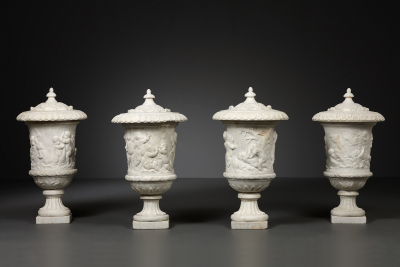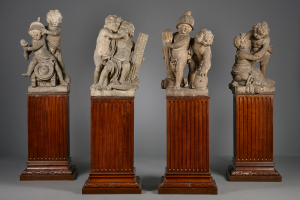Four Dutch Louis XIV sculptural marble vases
Four Dutch Louis XIV sculptural marble vases
Set of four garden vases, each with a square base and a tapering, scalloped foot capped with circular rings. The underside of each vase is decorated with leaf shapes and a woven band. The vases themselves are decorated with putti. The protruding lids are ornamented with leaf shapes and lobes and crowned with a round, scalloped knob.
Garden vases of this kind are purely decorative in purpose. Beneath their lids, these garden ornaments are a single solid whole, and as such have entirely lost their function as vases. These types of vases are modelled on the burial urns that the Romans used to store the ashes of their forebears. When people began to decorate gardens with archaeological items during the Renaissance, these urns were placed among the statues as artistic objects.
Holland also saw these elegant vases come into fashion in the latter half of the seventeenth century, and demand increased for marble garden vases inspired by Roman models – likely in imitation of the French. This is also visible in paintings from this period: vases of this type became a common theme from this point on, for example in Jan Weenix’s (1640-1719) grand hunt still-lifes.
Naturally, the garden vases were not only intended to demonstrate wealth and taste, but also knowledge of the ancients and Rome. As such, garden vases ranked among the most prestigious garden ornaments. Under the influence of Daniel Marot, the vases became even more elegant, and their use as architectural elements expanded to include not just gardens but interiors as well. Several examples of this can be found in Het Loo Palace in Apeldoorn.
Our garden vases are decorated with putti. In the artistic world, putti are small child-like figures, generally nude and wingless. The word derives from the Italian putto, meaning “young boy”, which in turn has its roots in the Latin putillus. Putti were commonly used both in allegorical scenes and for purely decorative purposes. They also often acted as playful personifications of the classical gods. In the seventeenth century, putti were referred to as kindertjes in Dutch, meaning “small children” or “young children”. A series of prints made by Gerbrand van den Eeckhout between 1640-55 shows a variety of putti at play, eloquently titled Eenige ordonnantie van verscheyde aerdige kindertjens, which loosely translates as An Arrangement of Various Friendly Children/Putti. In the arts, children represented innocence and playfulness, among other virtues, which enabled artists to use children to express certain symbolic messages without causing offence.
These four garden vases constitute two pairs: one with the theme of water, the other with the theme of land. The vases are clearly based on the famous marble plaquettes of François Duquesnoy (1597-1643) and various statues found in the gardens of the Palace of Versailles.
The first edition of Simon Thomassin’s Recueil des statues, groupes, fontaines, termes, vases, et autres magnifiques ornements du chateau & parc de Versailles (Collection of the Statues, Groups, Fountains, Termini, Vases and Other Magnificent Ornaments of the Castle & Park of Versailles) was published in Paris in 1694. A second edition followed in Amsterdam in 1695, and a Dutch translation was published in the eighteenth century, underscoring the popularity of Thomassin’s creation, which contained prints of statues and fountains. A remarkable example relating to our vases is a print of a lidless garden vase titled Ieux d’enfants – Children’s Games, or Children at Play.
Another noteworthy image in this publication shows a fountain sculpture of a seahorse and cherubs. It is quite possible that the sculptor who made the vases referred to this then-highly-fashionable book for inspiration.
The children playing with a billy goat are directly reminiscent of François Duquesnoy’s plaquettes, which were very famous and often imitated by painters and sculptors from the second half of the seventeenth century on.
Thematically, one might argue that these vases constitute two pairs that complement each other: two vases decorated with scenes on land and two with scenes on the water.
There are no gods to be seen on the four vases. We see only children with fish and seahorses and children with a wine barrel, a billy goat and grapes.
While these latter elements are often seen in celebrations of Bacchus, harvests and Ceres, the goddess of agriculture, the former often feature in scenes depicting the triumph of Neptune.
Any thematic connection between the two pairs of vases is purely conjectural. One candidate is the myth of Neptune and Ceres, in which Neptune disguised himself as a horse. In this manner, the god of the sea seduced the goddess of agriculture. A 1708 print by Bernard Picart shows cherubs frolicking around the horse, which lies curled around Ceres. From this perspective, the connection between the vases of earth and water would be found in the theme of love.
The four vases originate from Mouchy-le-Chatel castle in northern France. This castle was originally built during the Renaissance, but underwent many transformations throughout the centuries as its residents expanded and adjusted it to their tastes and needs. The first adjustments were made in the sixteenth century by the de Maricourt family, after which the castle became the property of the first duke of Noailles in the first half of the seventeenth century. Through a series of inheritances, it eventually came into the hands of the dukes of Mouchy, also members of House Noailles. In the latter half of the nineteenth century, the castle underwent a rigorous transformation, presided over by architect Hyppolite Destailleur, who was assisted in this project by sculptors Michel Lienard and Mathurain Moreau. Their refurbishment concerned not just the castle, but also a thorough redesign of its interior and the gardens, for which significant numbers of purchases were made from Parisian art and antique dealers. It is likely that these four vases found their way to the castle at that time.
- Provenance
- The Dukes of Mouchy, subsequently via succession
- Period
- ca. 1700
- Material
- Carrara Marble
- Dimensions
- 76 cm
- Diameter
- 40.00 cm
Global shipping available











